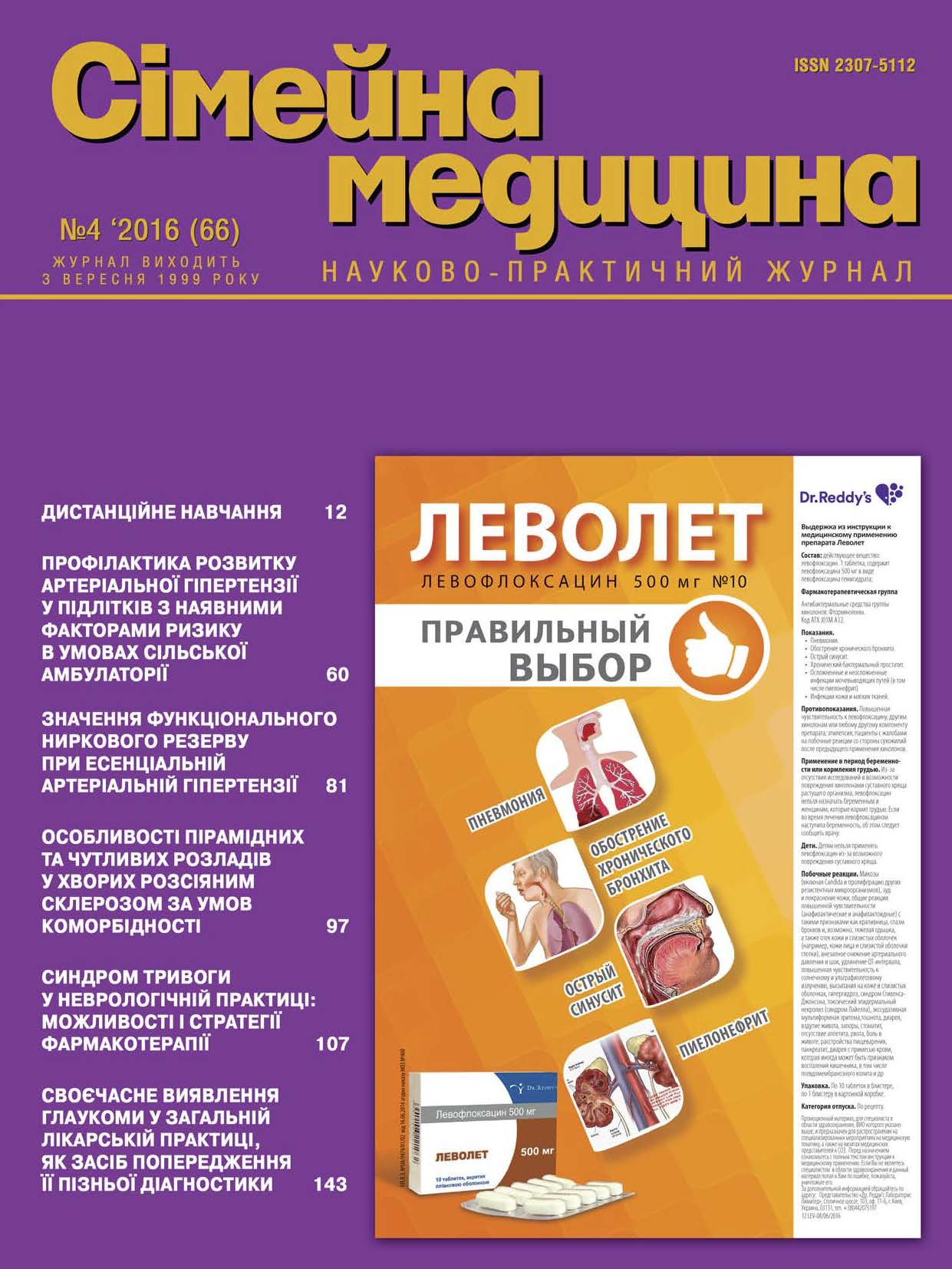Prevention of Arterial Hypertension in Adolescents with Existing Risk Factors in Rural Clinics
##plugins.themes.bootstrap3.article.main##
Abstract
The objective: to determine the frequency and impact of risk factors among adolescent children in the countryside on the possibility of arterial hypertension (AH) development and to devise the family doctor recommendations for its prevention.
Patients and methods. The cohort study of 214 children at the age of 12–17 years who attend Khotiv educational complex «Secondary school of I–III levels – gymnasium» in Kiev region was implemented in order to identify the elevated numbers of blood pressure (BP) and the impact of risk factors on the development of hypertension in future. The sociological poll about the existing risk factors for cardio-vascular disease, the measurement of height and weight with the following bodymass index (BMI) calculation, the Rufe’s test for evaluating the physical efficiency, the BP measurement in the office, the electrocardiography (ECG), the blood pressure daily monitoring (BPDM) and the ophthalmoscopy were carried out.
Results. Pre-hypertension was revealed among 29 children that made 13,6±2,3% of respondents, and arterial hypertension was diagnosed for 25 children that made 11,6±2,2%. Arterial hypertension was detected 2.5 times more often among boys in comparison with girls (8,3±1,9% and 3,3±1,5% accordingly). Most of respondents with arterial hypertension were 141year1old children. The most common complaints of the respondents were sleep disturbance (59,3±3,6%), exertional dyspnea (57,0±3,4%), headache (41,1±3,4%) and rapid fatigue (21,0±2,8%). The following risk factors as sex, hereditary factor for arterial hypertension especially combined with diabetes, myocardial infarction, stroke; smoking of respondents, smoking of parents, overuse of products containing the excess of table salt, insufficient use of vegetables and fruit (less than 200 g/day or no daily usage), the use of energy drinks, inactive way of life, low physical activity, the change of body weight (the overweight and the underweight) were significant.
Conclusions. The frequency of arterial hypertension among the examined children who live in the countryside is 11.6%, including 8.3% among boys and 3.3% among girls. The main risk factors of arterial hypertension are the overweight, the underweight, the family history of arterial hypertension, the smoking of parents and physical inactivity of children. It has been found out that the absolute risk of arterial hypertension development in future is 40 per cent higher among the smokers, 10 per cent higher among the children whose parents smoke, 20 per cent higher among the dyspn(o)eic respondents, 20 per cent higher among the underweight children, 30 per cent higher among the overweight children, 30 per cent higher among the children with the changes of the fundus of eye, 20 per cent higher among the children with sinus tachycardia and 40 per cent higher among children with a single supraventricular extrasystole or sinus arrhythmia.
##plugins.themes.bootstrap3.article.details##

This work is licensed under a Creative Commons Attribution 4.0 International License.
Authors retain the copyright and grant the journal the first publication of original scientific articles under the Creative Commons Attribution 4.0 International License, which allows others to distribute work with acknowledgment of authorship and first publication in this journal.
References
Богмат Л.Ф. Поширеність артеріальної гіпертензії та її факторів ризику у школярів популяції м. Харкова / Л.Ф. Богмат, Л.І. Пономарьова // Артериальная гипертензия. – 2009. – № 2 (4) [Електронний ресурс]. – Режим доступу: http://www.mif-ua.com/archive/article/8565.
Гайдук Т.А. Артеріальна гіпертензія у підлітків з високим ризиком кардіоваскулярних захворювань: Автореф. дис. … канд. мед. наук: 14.01.10 / Т.А. Гайдук; Дніпропетр. держ. мед. акад. МОЗ України, Ін-т гастроентерології АМН України. – Д., 2010. – 21 с.
Іванько О.Г. Досвід організації фізичної реабілітації підлітків 16–17 років з артеріальною гіпертензією в умовах навчального закладу / О.Г. Іванько, Є.Л. Михалюк, В.Я. Підкова та ін. // Современная педиатрия. – 2014. – № 3 (59). – С. 89-93.
Коренєв М.М. Артеріальна гіпертензія та ожиріння в підлітків / М.М. Коренєв, Л.Ф. Богмат, О.М. Носова // Український журнал дитячої ендокринології. – 2014. – № 2. – С. 79-80.
Коренєв М.М. Артеріальна гіпертензія у підлітків: фактори прогнозу перебігу / М.М. Коренєв, Л.Ф. Богмат, О.М. Носова [та ін.] // Артериальная гипертензия. – 2011. – №1 (15) [Електронний ресурс]. – Режим доступу: http://www.mif-ua.com/archive/article/15930.
Ледяев М.Я. Оценка факторов риска и профилактика развития артериальной гипертензии у подростков / М.Я. Ледяев, Ю.В. Черненков, Н.С. Черкасов [и др.] // Лечащий врач. – 2012. – № 6. – С. 4-6.
Леонтьева И.В. Поражение органов-мишеней у детей и подростков с артериальной гипертензией // Российский вестник перинатологии и педиатрии. – 2010. – № 2. – С. 30-41.
Малахова С.М. Сучасний погляд на проблему АГ у підлітків // Патологія. – 2014. – № 3 (32). – С. 10-15.
Плотникова И.В. Влияние факторов риска развития сердечно-сосудистых заболеваний на формирование эссенциальной артериальной гипертензии в подростковом возрасте / И.В. Плотникова, В.В. Безляк, И.А. Ковалев // Педиатрия. – 2011. – № 5. – С. 11-15.
Хайтович М.В. Діагностика артеріальної гіпертензії у дітей та підлітків // Медична газета «Здоров’я України». – 2014. – С. 38-39.





